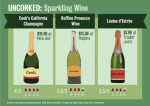Life is filled with moments shared over a glass of wine, whether fueling a gossip session with friends, or destressing after a long day of school. But what are the best options for the average broke college student who can’t afford a $50 bottle of wine? Each week, columnist Susana Alcantar will discuss different wine options for under $15, where to get them in Westwood and which are worth your money.
No New Year’s Eve celebration is complete without flutes of bubbly wine.
Many of us are familiar with sparkling wine, although we often refer to it as Champagne. However, most of the Champagne can’t be labeled as Champagne unless it was specifically made in the Champagne region of France.
As I shopped for sparkling wines, I decided to purchase sparkling wines from different regions, as I’ve heard different regions can result in different tastes.
The first wine I purchased was Cook’s Brut California Champagne for $10.99 at Rite Aid. When I saw the bottle I was confused as to why it said Champagne on the label when it wasn’t made in France. After some online research, I discovered sparkling wines made in the United States can be labeled as Champagne if produced prior to 2006.
I got back home and immediately opened the bottle to share a glass with my roommate, celebrating our last days of freedom as midterms approached. The color of the wine was a pale yellow, almost transparent. It was also very carbonated, which made me smile – the bubblier the wine, the better.
As I took a sip, I felt the bubbles tingle in my mouth and I loved it. I tasted apple and peach flavors but they were not overpowering – if anything, I would have liked for the fruit flavors to be even more well-defined. However, the wine did taste a bit watered down, a problem I have encountered with previous wines as well.
I also bought an Italian wine called Ruffino Prosecco for $12.84 from Ralphs, which I was excited to try due to my previous experience with an Italian sparkling wine a few years ago at a wedding.
The color of the Ruffino was darker than the Cook’s and the wine was not as bubbly, but I preferred the subtle fruity smell of this wine over the previous one because it was not as intensely sweet.
The taste of the wine also reflected its toned-down aroma – it was dry but not to the point where it started to feel too heavy to drink. In fact, the fruit flavors seemed almost nonexistent as I drank the wine. The description on the bottle said it should have lingering fruit notes, but they dissipated after a short while.
The final wine I purchased was Louise d’Estree Methode Traditionnelle Brut for $7.99. It’s the cheapest option out of the three and also happens to be French, which is supposedly the best kind of Champagne.
As soon as I saw the color – a dark, unattractive shade of yellow – I was apprehensive. However, I liked the smell, sensing nuanced floral notes with minor fruit flavors, a combination I did not encounter with the previous two wines.
The wine fizzled as I drank it, hitting me with hints of citrus. I didn’t really pick up any of the fruit flavors, but I did detect the strong floral notes in the drink. Though refreshing, I wished the wine had a little more kick.
To my surprise, the wine I liked best was the Cook’s California Champagne Brut. It was a good combination of bubbliness and fruity flavors unlike its European counterparts, and it was also the only one out of the three options that warranted a second glass. I originally predicted the French option would be my favorite, but I was wrong – surprisingly, French Champagne isn’t always the best.
